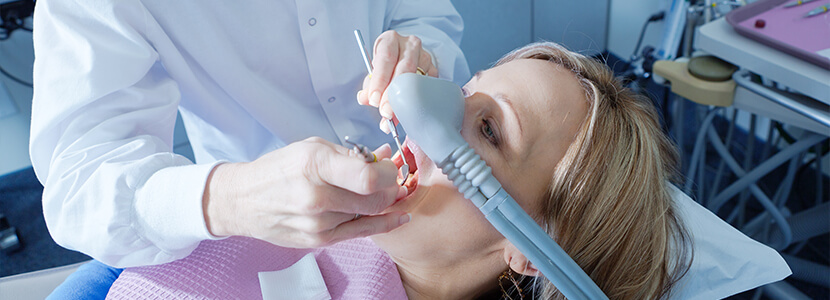Nitrous oxide
Definition :
The equimolar oxygen-nitrous oxide 50% / 50% mixture (often abbreviated as MEOPA) is a gaseous mixture, at fixed concentrations, used in analgesia. The active substance of this drug is nitrous oxide, a colorless, non-irritating, low-odor gas. Not very soluble in the blood, it provides a rapid effect after three minutes of inhalation, this effect is quickly reversible in 5 minutes after stopping. The concentration of nitrous oxide causing anesthetic sleep (MAC) is 104%, impossible to achieve in current practice (this figure was evaluated in hyperbaric conditions). Nitrous oxide, discovered in 1772 by English chemist and pastor Joseph Priestley, had its medically demonstrated relaxing and analgesic effects framed in the United States in 1844 by dentist Horace Wells.
Mode of action :
Nitrous oxyde has a triple action : anxiolytic (decreased anxiety) ; analgesic; amnesic (in a moderate way and more particularly in children). It does not lead to sleep or deep sedation but a modified state of consciousness (the sounds, noises and lights can be disturbed), with the maintenance of the verbal contact that the 'we call' conscious sedation '. It is not considered as analgesic in the classification and levels of the WHO, and it can be used according to the pains felt by the patient in parallel with analgesics of different levels during painful gestures provoked (punctures, sutures, etc...).Indication :
Because of its low potency, MEOPA should only be used for less painful procedures (EVA 4 to 6), in combination if necessary with local anesthesia, patch of EMLA or subcutaneous Xylocaine.The presentation in equimolar mixture with 50% of oxygen, O2, practically eliminates the risk of hypoxia and improves the safety of administration at the cost of an analgesic action comparable to a subcutaneous injection of 10 mg of morphine. In France, the marketing authorization (AMM) of November 2001 establishes that the administration of MEOPA is not part of a general anesthesia performed in the operating room by an anesthesiologist. The nitrous oxide MA alone describes it as an adjuvant to GA and used in concentrations of 30-70% on an anesthetic respirator. MEOPA used outside the operating room alone does not have sufficient power to reach a surgical depth of sedation. It is not essential that this product be administered by an anesthesiologist, but doctors, dentists and paramedical professions after compulsory training are authorized to implement it. Fasting and monitoring are not mandatory, simple monitoring validates conscious sedation and thus the response to simple orders.
Frequently used in the hospital, as well as in the pediatric and emergency departments because of his maneuverability and the atraumatic nature of the administration (one does not make an injection, one inhales this medicine through a mask and this fact must be explained to the patient for a greater success of this treatment). Its maneuverability also allows extra-hospital use in vehicles by "mobile" doctors and nurses of the Emergency services and Fire Brigades. It can also be used in obstetrics if it is impossible (no anesthetist present), or facing refusal or ineffectiveness of epidural anesthesia. Since the authorization to market it in November 2009 with the release of the hospital reserve, the MEOPA is also available for dentists, general practitioners (such as mountain rescuers) and specialists (dermatologists ...). It potentiates antalgic and anxiolytic drugs, the risk of respiratory depression being then potential in case of associations with opioid acting on mu2 receptors.


